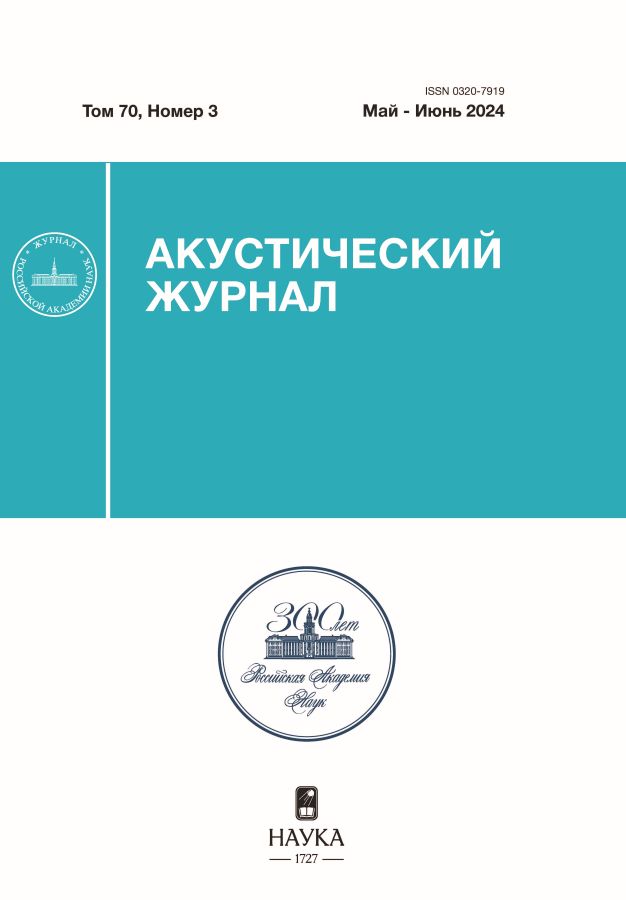Chuprov invariant for vector-scalar fields of multipole sources in a shallow sea
- Authors: Kuznetsov G.N.1,2, Stepanov A.N.1,2
-
Affiliations:
- Institute of General Physics named after. A.M. Prokhorov RAS
- Samara National Research University named after academician S.P. Koroleva
- Issue: Vol 70, No 3 (2024)
- Pages: 78-90
- Section: АКУСТИКА ОКЕАНА. ГИДРОАКУСТИКА
- URL: https://rjmseer.com/0320-7919/article/view/648418
- DOI: https://doi.org/10.31857/S0320791924030087
- EDN: https://elibrary.ru/ZMAIZD
- ID: 648418
Cite item
Abstract
A computational and theoretical study of the properties of the well-known waveguide invariant S.D. Chuprova (IC) was carried out in a plane-parallel Pekeris waveguide. Unlike earlier works, in which predominantly non-directional (monopole) sources were used as a source, and sound pressure fields (scalar fields) were studied, in this work not only scalar, but also vector fields formed in the waveguide by directional - combined multipole sources with directivity in both horizontal and vertical planes. A differential equation has been obtained that makes it possible to fairly accurately calculate the IC values under different conditions of signal propagation and different depths of sources and receivers. This makes it possible, in a simpler way than “full computer modeling,” to predict the invariance (stability) of the IC when varying both the hydrophysical conditions in the waveguide and the geometry of the experiment. It is shown that the directionality of sources in the horizontal plane has virtually no effect on the properties of the IC, and the directionality in the vertical plane leads to a shift in the fan structure of the signal amplitude fields, but has little effect on the IC values. The properties of the fan structure change in a similar way when using vertical projections of the oscillatory velocity vector - despite the fact that another analytical relation, different from scalar fields, is used to calculate the IC, the IC value is close to (+1) at all frequencies and distances, except those at which new modes or dislocations arise. At these frequencies and in these zones, alternating emissions with different signs and magnitudes occur. It is concluded that the stability of IC allows the application of signal processing algorithms developed for scalar fields and non-directional sources to vector-scalar fields generated, including using directional sources.
Full Text
About the authors
G. N. Kuznetsov
Institute of General Physics named after. A.M. Prokhorov RAS; Samara National Research University named after academician S.P. Koroleva
Author for correspondence.
Email: skbmortex@mail.ru
Russian Federation, st. Vavilova 38, Moscow, 119991; Moskovskoe highway 34, Samara, 443086
A. N. Stepanov
Institute of General Physics named after. A.M. Prokhorov RAS; Samara National Research University named after academician S.P. Koroleva
Email: skbmortex@mail.ru
Russian Federation, st. Vavilova 38, Moscow, 119991; Moskovskoe highway 34, Samara, 443086
References
- Чупров С.Д. Акустика океана: современное состояние. М.: Наука, 1982. С. 71–91.
- Орлов Е.Ф., Шаронов Г.А. Интерференция звуковых волн в океане. Владивосток: Дальнаука, 1998. С. 8–26.
- Грачев Г.А. К теории инвариантов акустического поля в слоистых волноводах // Акуст. журн. 1993. Т. 39. № 1. С. 67–71.
- Бреховских Л.М., Лысанов Ю.П. Теоретические основы акустики океана. М.: Наука, 2007. 369 с.
- Aksenov S.P., Kuznetsov G.N. Determination of interference invariants in a deep-water waveguide by amplitude and phase methods // Phys. Wave Phenom. 2021. V. 29. № 1. P. 81–87.
- Кузнецов Г.Н., Кузькин В.М., Пересёлков С.А. Спектрограмма и локализация источника звука в мелком море // Акуст. журн. 2017. Т. 63. № 4. С. 406−418.
- Kuznetsov G.N., Kuz’kin V.M., Pereselkov S.A., Kaznacheev I.V., and Grigor’ev V.A. Interferometric Method for Estimating the Velocity of a Noise Sound Source and the Distance to It in Shallow Water Using a Vector-Scalar Receiver // Phys. Wave Phenom. 2017. V. 25. № 4. Р. 299–306. https://doi.org/10.3103/S1541308X17040100
- Kuznetsov G.N., Stepanov A.N. Interference and Phase Invariants of Sound Fields // Phys. Wave Phenom. 2021. V. 29. № 3. P. 285–292.
- D’Spain G., Kuperman W. Application of waveguide invariants to analysis of spectrograms from shallow water environments that vary in range and azimuth // J. Acoust. Soc. Am. 1999. V. 106. № 5. P. 2454–2468.
- Kevin L., Cockrell K., Schmidt H. Robust passive range estimation using the waveguide invariant // J. Acoust. Soc. Am. 2010. V. 127. № 5. P. 2780.
- Zhao Z., Wu J., Shang E. How the thermocline affects the value of the waveguide invariant in a shallow-water waveguide // J. Acoust. Soc. Am. 2015. V. 138. № 1. P. 223.
- Song H., Cho C. The relation between the wave guide invariant and array invariant // J. Acoust. Soc. Am. 2015. V. 138. № 2. P. 899.
- Урик Р.Дж. Основы гидроакустики. Л.: Судостроение, 1978. 445 с.
- Кузнецов Г.Н., Степанов А.Н. Векторно-скалярные поля мультипольных гидроакустических источников, эквивалентных шумоизлучению морских объектов. М.: Буки-Веди, 2022. 304 с.
- Гордиенко В.А., Ильичев В.И., Захаров Л.Н. Векторно-фазовые методы в акустике. М.: Наука, 1989. 223 с.
- Гордиенко В.А. Векторно-фазовые методы в акустике. М.: ФИЗМАТЛИТ, 2007. 480 с.
- Аверьянов А.В., Глебова Г.М., Кузнецов Г.Н. Экспериментальное исследование характеристик направленности векторно-скалярной антенны // Акуст. журн. 2011. Т. 57. № 5. С. 681–694.
- Белова Н.И., Кузнецов Г.Н. Сравнение однонаправленного приема сигналов в волноводе с использованием линейных векторно-скалярных и комбинированных антенн // Акуст. журн. 2013. Т. 59. № 2. С. 255–267.
- Кузнецов Г.Н. Проблемы оценки приведенной шумности движущихся объектов в мелком море // Труды Всероссийской научно-технической конференции «Метрология гидроакустических измерений» (25–27 сентября, Менделеево). Менделеево: ФГУП "ВНИИФТРИ", 2013. Т. 1. С. 57–74.
- Aksenov S.P., Kuznetsov G.N. Determination of Interference Invariants in a Deep-Water Waveguide by Amplitude and Phase Methods // Phys. Wave Phenom. V. 29. P. 81–87. https://doi.org/10.3103/S1541308X21010015
- Бреховских Л.М. Волны в слоистых средах. М.: Наука, 1973.
- Кузнецов Г.Н., Степанов А.Н. Приближенные аналитические представления законов спадания векторно-скалярных полей мультипольных источников в волноводе Пекериса // Акуст. журн. 2017. T. 63. № 6. С. 623–636.
- Кузькин В.М., Переселков С.А. Интерферометри-ческая диагностика гидродинамических возмущений мелкого моря. М.: Ленанд, 2019. 200 с.
Supplementary files




















